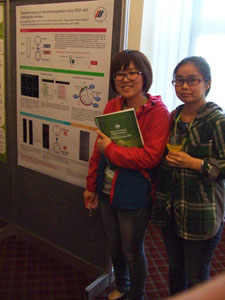若手渡航支援
本新学術領域では、若手海外旅費支援基金を設け、海外の国際学会等へ参加する若手研究者の旅費をサポートしています。
●村井 周平
埼玉大学大学院理工学研究科・M2
(竹澤大輔 グループ)
2014年9月25日から28日にかけて、「植物環境突破力」海外若手渡航の支援を受けて、中国・北京で開催されたThe 17th Annual MOSS International Conference(MOSS 2014)に参加しました。この学会は、世界中の主にヒメツリガネゴケを扱う研究者が分野を問わず集まり、発表を行うものです。
私はゼニゴケにおけるアブシジン酸受容体遺伝子の機能についてポスター発表を行いました。この学会が行われた Capital Normal University にはヒメツリガネゴケにおけるアブシジン酸受容体遺伝子の機能について研究されている研究室があり、2時間という限られた時間の中でポスターに載せきれなかったデーターまで使い有意義な議論を行うことができました。特にゼニゴケのアブシジン酸受容体遺伝子がどの様なストレス応答に関わるのかについて、とても興味を持っていただきました。
また、他の方の発表では、高山に生育し、苔類と鮮類両方の特徴を合わせ持つTakakiaをストレス応答の研究に活用できないかというゲノム解析のお話や、ヒメツリガネゴケの持つあるmiRNAがABAの合成や乾燥ストレス耐性獲得の制御に関わるお話など、興味深いお話を聞く事が出来ました。
最後に、この様な貴重な機会を与えて下さった「植物環境突破力」海外若手渡航支援に深く感謝いたします。
●松永 航
北海道大学大学院生命科学院・D2
(伊藤秀臣 グループ)
「植物環境突破力」若手渡航支援を受け、2014年の7月28日から8月1日においてカナダ、バンクーバーにおいて開催された「25th International Conference on Arabidopsis Research」に参加してきました。昨年に引き続きご支援をいただき、本国際会議に出席できましたこと、大変感謝しております。
私は、シロイヌナズナにおいて熱ストレスで活性化するレトロトランスポゾンの制御機構についてポスター発表を行いました。トランスポゾンの専門家のみならず、様々な専門の方に発表を聞いていただくことができ、このトランスポゾンに興味を持っていただけたのではないかと感じております。また私自身も環境ストレス応答や、エピジェネティクス、花成といった分野を中心にポスター発表を聞いて回り、今後の研究を進めるうえで大変参考になる議論を行うことができました。
口頭発表ではエピジェネティクス分野の発表が、初日の午前中に最も大きな会場で行われ、午後にも別の会場で行われました。質疑が多く、活発に行われており、大変興味深いものでした。
学会期間中のバンクーバーは連日晴天に恵まれ、心地よい環境のなか参加することができ、このような機会を与えていただいた「植物環境突破力」若手渡航支援に深く感謝いたします。
●山下 由衣
北海道大学大学院農学研究院・博士研究員
(内藤哲 グループ)
2014年7月6日から11日にアメリカ、モンタナ州、Big Sky で開催された、9th FASEB meeting on "Post-transcriptional control of gene expression: Mechanisms of mRNA degradation" に参加させて頂きました。
新千歳空港を出発し、ほぼ丸一日かけてオフシーズンのスキーリゾートに到着しました。Big Skyはあまりにものどかな所で、本当にこんな所で学会が開催されるのだろうかと疑問に感じたほどです。しかし、続々と有名な研究者が学会会場に到着し、いよいよ始まるのだと確信しました。今回のFASEB meetingの最大の魅力は、「mRNA 分解」という比較的狭い研究分野に焦点をしぼり、少人数 (150人弱) で行われた点です。そして、ほとんどの参加者が学会会場と同じホテルに宿泊していたため、約5日間「mRNA分解」について、密な議論や情報交換から、良い刺激を受けることが出来ました。
私は、シロイヌナズナのCGS1 mRNAで起こる翻訳アレストと共役したmRNA分解について、昨年度にGenes Genet. Syst. 誌とJ. Biol. Chem.誌に掲載された内容を、2枚のポスターで発表しました。それぞれの発表について、mRNA分解分野の専門家からご意見を頂き、議論しました。特に生化学的な手法によってリボソームの追突について調べた私の研究成果について、リボソームプロファイリング法を用いた最新の研究と非常に整合性が取れていると評価頂けたことは自信につながりました。
最後に、このような有意義な機会を与えて下さった植物環境突破力・若手渡航支援に心より感謝申し上げます。
●安喜 史織
奈良先端科学技術大学院大学バイオサイエンス研究科・博士研究員
(梅田正明 グループ)
6月29日から7月4日にかけてプラハで開催された「Auxins and Cytokinins in Plant Development International Symposium 2014」に参加しました。ヨーロッパを中心に世界中の研究者が一堂に会し、さまざまな植物ホルモンの研究についての発表、議論が行われました。
非常に興味深いと感じたことは、独特の自己紹介です。名前とどこの国から来たのかを紹介した後、必ず「オーキシン?サイトカイニン?」という質問を受けます。質問の意図が分からないなと思いつつもサイトカイニンに興味を持っているので「サイトカイニンだ」と伝えると、相手がオーキシンをテーマに研究をしていれば「ふーん」(もちろんその後研究についての話はしますが…)、サイトカイニンの仕事をしていれば「同じね!!」という返答がくるのです。不思議な文化に少々戸惑いながらも、いろいろな方と言葉を交わし、非常に楽しく有意義なひとときを過ごすことができました。学会期間中ずっとひとつの部屋でホルモンの研究についての発表と議論だったので本当に良い勉強になりました。
私はポスター発表で植物用細胞周期マーカーの紹介を行いました。予想通り植物ホルモンに関連しない唯一?のポスターでしたので、発表当日までは「参加者の方々に違和感を与えるのではないか、興味を持ってもらえるのか」とかなり不安でした。しかし、実際に学会が始まってみるといろいろな方が私のポスターに興味を持ってくださり、応用できるのではないかと議論を交わすことができました。
すばらしい機会と出会いを与えてくださった「植物の環境突破力」若手渡航支援に深く感謝いたします。
●Bart Rymen
理化学研究所環境資源科学研究センター・博士研究員
(杉本慶子 グループ)
This year, the international conference on Arabidopsis research (ICAR) was held at the University of British Columbia in the beautiful city of Vancouver, Canada. The meeting was held over 5 days from Monday, July 28th to Friday August 1st. A total of 157 presentations and 9 additional workshops were scheduled and more then 400 posters were exhibited.
As the name suggests the ICAR focuses on recent research and developments in plant biology that uses Arabidopsis thaliana as a research model. Due to the importance of research on Arabidopsis in plant biology, the ICAR conferences have grown to represent one of the premier venues for international exchange of the latest advances in basic plant biology. The meeting was held already for the 25th time, which called for some retrospective and future vision on the position of Arabidopsis research. Therefore keynote lectures by much respected plant biologist Dr. Jeff Dangl, Dr. Xumei Chen and Dr. Peter McCourt focused on how research on Arabidopsis significantly contributed to their respective research fields and provided their vision for future Arabidopsis research. It was clear from these keynotes, recent technical advantages in high-throughput sequencing and multiple plant genomes being sequenced helps research on crop species advancing. Consequently, in some aspects Arabidopsis is losing its role as the sole plant model for molecular biology. Nevertheless Arabidopsis has still multiple advantages. The three main named are its easiness by which it is transformed, making it the ideal model for the generation for molecular biology. Second, its small genome has major advantages for the creation of different mutant alleles for each gene, which will and has contributed al lot in the functional characterization of genes. Third, its short generation time and small size, makes it the ideal model for high-throughput genetics. In the future, it will be key to use these advantages to the fullest for a significant contribution of Arabidopsis research to the understanding of plant biology.
These advantages could be used to start "synthetic gene analysis (SGA)", a tool that was introduced by the fourth Keynote speaker, Dr. Brenda Andrews. She presented her research in yeast on synthetic gene analysis to advance the understanding of all gene function. Basically, she has developed tools for the systematic construction of double mutants that enable a global analysis of synthetic lethal genetic interactions. Using this tool she screened for essential redundancy between genes under a variety of conditions. Also in plant research, functional analysis of genes is often hampered by redundant gene function. The possibility to employ the easiness of Arabidopsis genetics and transformation to make Arabidopsis a lead model in a similar systematic analysis of genetic redundancy in plant research was discussed.
Plenary sessions and concurrent seminar sessions were held on a large variety of topics. I choose to attend sessions dealing with development, epigenetics, systems biology, cell biology and new tools and techniques. Here I will present a few of the highlights. I was impressed how different techniques are emerging that enable the characterization of proteins, epigenetic marks, transcription factor binding in specific cell types and even in single cells. Dr. Siobhan Brady showed how differential epigenetic marking in vascular versus non-vascular cells is important for vascular identity specification. Dr. Ross Sozzani showed techniques that enable the quantification of movement and quantification at the subcellular level. Another emerging topic was the systematic identification of cis-regulatory elements. So far transcription factor binding sites have been only poorly understood. Now, multiple techniques were applied to understand transcription control elements in the genome better. The shown results of Dr. Joe Ecker and Dr Christine Queitsch were most promising. Dr Ecker uses arrays of small oligos to define the core binding sequences of transcription factors, while Dr. Queitsch uses DNase I based genomic footprinting, to distinguish between occupied and non-occupied regions in the genome. In combination with deep sequencing techniques, she showed to be able to define the transcription factor binding sites. Application of these techniques under different conditions allowed building regulatory networks. Also results obtained with Genome wide association mapping (GWAS) on root developmental traits by Dr. Wolfgang Bush were very impressive. He managed to combine detailed phenotyping techniques with the large natural variation in Arabidopsis accession to identify gene not known to contribute to root development. I contributed to the vegetative development session, chaired by Dr. Kim Gallagher. I presented a short presentation and poster, which gave me a good forum to discuss my work with different renowned scientist in the plant developmental research field. In general, my research on the regulation of growth under limiting conditions was well received, and during poster session I got multiple good suggestions and discussion.
I really appreciate the project of POWER TO OVERCOME ENVIRONMENT for the financial support to enable to attend the ICAR meeting. I am sure the contacts I made during this meeting will help me in my future career development and my work will profit from all the suggestions and discussion during this conference.
●高橋洋平
名古屋大学大学院理学研究科・研究員
(木下俊則 グループ)
2014年7月12日から16日にかけて、「植物の環境突破力」若手渡航の支援を受けて、アメリカ合衆国オレゴン州ポートランドで開催されたPlant Biology 2014に参加しました。生理学の基礎研究をはじめ、育種やシステムバイオロジーなど多岐にわたる分野の植物研究者が世界各地から一堂に会して発表や議論が行われました。
私は、植物ホルモンのアブシジン酸情報伝達を担う転写因子のリン酸化による制御機構について、ポスター発表を行いました。発表は3日間あり、質疑応答に立つ時間が毎日設けられていたので、たくさんの参加者に発表を聞いてもらうことができ、カリフォルニア大学サンディエゴ校のJulian I. Schroeder教授(写真)など著名研究者とも議論できたことは良い経験になりました。自分自身も多くのポスター発表を聞くことができ、特に、光や植物ホルモンの情報伝達について幅広く情報収集することができました。また今回は、ポスター発表者に自身の要旨やメールアドレスなどの情報が印刷されたカードが25枚ずつ用意されました。これを各自ポスター横に設置して配布することで、発表の記録や整理が容易になるのみならず、研究者同士の交流の一助にもなる面白い仕組みでした。
口頭発表は、一日あたり大きなシンポジウムが2つと、ポスターから選ばれた発表者によるミニシンポジウムが6つ程度あり、それぞれ発表者が5名程度と、比較的少数でした。その中で、食料問題について大きなシンポジウムが2つ設けられ、立ち見が出るほど盛況だったのが印象的でした。植物が作る食料としての有用成分の研究から、今後の人口増加に伴って予想される食料供給不足問題とその対策まで、各分野の専門家による講演は大変興味深いものでした。植物研究者が共有できる課題として、専門を問わず注目されているのを感じました。ミニシンポジウムの演題は主に若手研究者から選ばれ、FRETを応用して植物ホルモンの動態を可視化するバイオセンサーの開発やゲノム編集などを含む新しい技術等について、未発表データを用いた面白い発表が多数ありました。
今回のPlant Biology 2014への参加により、関連分野の動向などを含む有益な情報を収集でき、加えて、著名研究者や同年代の若手との交流の機会を得ることができました。貴重な機会を与えていただいた「植物の環境突破力」若手渡航支援に深く感謝いたします。
●市川 美恵
京都府立大学大学院生命環境科学研究科・D3
(佐藤雅彦 グループ)
2013年6月24日から28日までオーストラリアのシドニーで行われた「24th International Conference on Arabidopsis Research」に参加しました。会場の目の前は港という最高のロケーションで、季節的には11月を思わせる少し肌寒いところでした。ポスターセッションにおいて、私はクラスリンの脱被覆に関わっているとされるSH3Pタンパク質について発表しました。SH3Pが塩ストレスや重力屈性に関与していることを拙い英語で頑張って伝えましたが、少しは伝わったのか、質問やコメントも頂けました。色々と足りない実験があることが分かり、実験計画の再考が必要と感じました。他のポスターの演者とも話をし、良い情報を得ることができました。時々雑談も挟みつつ、海外の方と交流できた事は、大変刺激になりました。いつかは,私も英語で口頭発表できるように努力しようと思います。
他の研究者の人達の発表では,タンパク質の相互作用をイメージングを用いて時空間的に観察した発表や、実験手法に関する発表に研究のヒントを得ることができました。私は、根を痛めずに阻害剤実験を行う方法を模索していましたが、良いヒントが得られました。篠崎先生の特別講演では,乾燥ストレスに関するお話を聞き、大変勉強になりました。また、Small ORFの論文を拝読していましたが、その論文には載っていないこともお話頂き,とても興奮しました。以上、本学会に参加したことによって、様々な知識が得られ、よい経験ができたと思います。この経験を生かせるよう、日々精進しようと改めて感じました。
●大濱 直彦
東京大学大学院農学生命科学研究科・D2
(篠崎和子 グループ)
私は6月24日から28日にかけて、オーストラリアのシドニーで開催された24th International Conference on Arabidopsis Research (ICAR)に参加しました。この学会では、主にシロイヌナズナを研究材料とする研究者たちが集まり、様々な分野の研究に関して発表や意見交換が行われます。私も高温ストレス応答の制御に関わる転写因子の解析という内容でポスター発表を行いました。質疑応答では英語力の向上の必要性を痛感させられましたが、自分とは異なる視点から植物を研究している人たちからの指摘、質問は、今後研究を進める上で大変参考になるものでした。
シンポジウムやワークショップでは様々な分野の発表がありましたが、特に普段触れる機会が少ない分野の発表を意識して聞きにいきました。中でも最新の技術を用いた研究は興味深く、こんなこともできるのか、と驚く場面が何度もありました。例えば、細胞の分化に関する研究発表では特定の種類の細胞だけを単離して解析する技術が用いられていました。それらの研究では、細胞の種類ごとにトランスクリプトームやエピジェネティックな特徴の違いを調べており、幹細胞の維持や分化の仕組みの解明につながる有用な手法であることが感じられました。また、今回のICARの口頭発表では、多くのの枠が優れた研究をしている若手研究者に与えられており、その枠では自分と同じ学生も多く発表していました。彼らの発表する姿を見ていると、自分の研究もあのような優れたものにしていきたいという思いが沸き上がり、大変よい刺激を受けることができました。
●松永 航
北海道大学大学院生命科学院・D1
(伊藤秀臣 グループ)
「植物の環境突破力」若手渡航支援を受け、2013年6月24日から28日に、オーストラリア、シドニーで開催された24th international Conference on Arabidopsis Research (ICAR2013) に参加させていただきました。本国際会議は、モデル高等植物として広く利用されているシロイヌナズナの研究者交流の場として、ほぼ毎年開催されています。私は、 A retrotranspositional regulation of a heat-activated retrotransposon というタイトルでポスター発表を行い、シロイヌナズナで同定された熱活性型レトロトランスポゾンの転移制御機構について、多くの研究者と意見を交えながら議論を行いました。1時間という限られた時間の中で多くの方に来ていただき、今後の研究を進めていくにあたって、参考となる貴重なコメントを頂くことができました。また、各セッションやワークショップ等の講演においては、著名な研究者の発表を聞くことができ、よい刺激となりました。この貴重な経験は今後、自身の研究発表に活かしていくことができると考えています。
●高塚 大知
奈良先端大学院大学バイオサイエンス研究科・博士研究員
(梅田正明 グループ)
私は2013年7月3日から6日にスペイン・バレンシアで開催された"Society for Experimental Biology 2013"に参加させて頂きました。日本では比較的馴染みの薄い学会ですが、ヨーロッパの研究者を中心としたとてもハイレベルな学会でした。特に私が携わっている植物の細胞周期研究分野においては、第一線の研究者が軒並み顔を揃えて、2日間に亘って最新の研究成果を報告するというとてもエキサイティングな時間を過ごすことができました。論文としては未発表の最新の知見も多く報告され、どのような研究が主流になっていきているのかを把握できました。また、どのような技術を使うことができるのか、それらを使ってどのようなアプローチが可能なのか、日頃研究室に籠って研究しているだけでは得られない貴重な情報が多く得られ、とても実りの多い学会でした。また、自身の研究発表においても有意義な機会になりました。海外の研究者とそれぞれの研究成果を議論することも普段はなかなかできないことであり、多くの貴重なアドバイスを頂くことができたと同時に、自分の語学力・ディスカッション力の不足を痛感させられました。また一流の研究者と自分の距離感を明確に感じることができ、より一層の精進を決意することができました。
この度はこのような貴重な経験を積むにあたり、若手渡航支援を頂き、ありがとうございました。
●反田 直之
東京大学農学生命科学研究科・M2
(藤原徹 グループ)
渡航期間は2013年8月16日から23日まで、その間にトルコ イスタンブールにて行われたIPNC '13(XVII INTERNATIONAL PLANT NUTRITION COLLOQUIUM) およびそのサテライト会議のBORON '13 に参加、研究成果の発表をさせていただきました。
BORON '13 はイスタンブールのThe Marmara Hotelにて17-18日に行われ、参加者はおよそ80人でした。発表はポスターのほか、5つのセッションからなる口頭発表で行われました。主にホウ素欠乏や過剰障害、ホウ素の輸送機構についてシロイヌナズナ、コムギ、オオムギ、ナタネやスイカなど様々な植物種を研究対象とした研究発表が行われました。私はシロイヌナズナにおけるホウ素過剰障害に関する研究成果についてポスター発表を行い、他の参加者から研究内容に関する質問や意見を頂き、議論を行いました。
IPNC'13はIstanbul Convention and Exhibition Center にて19-22日に行われました。2つの会場で口頭発表が行われ、300題以上のポスター発表が行われました。私はRhizosphere Process Root Biology and Nutrient Acquisitionセッションにて、根の生育が異常なシロイヌナズナ変異株に関する研究成果の発表を行いました。他の参加者の発表内容は多岐にわたるものでしたが、さまざまな植物種を対象とした、施肥や栽培方法による生育の違いを調べた生理学的研究が多く、分子生物学、遺伝学的な研究は比較的少なかったという印象を受けました。特別セッションとしてカリウムセッションが設けられ、カリウムの吸収や利用効率に関する研究内容が多く発表されていました。
両会議において、多くの日本国外の研究者と交流し、議論することができました。修士学生のうちにこのような貴重な経験ができたことを、「植物の環境突破力」若手渡航支援に深く感謝いたします。
●陳 志長
岡山大学自然科学研究科・D3
(馬建鋒 グループ)
The International Plant Nutrition Colloquium (IPNC) is held every four years since the early 1950's. It provides a forum for scientists, students and publics to increase the knowledge of the fundamental principles in the field of plant nutrition, to develop and optimize field practices and to improve public policies and management approaches. The colloquium has attracted many people from different countries, and has become the most important international meeting on fundamental and applied plant nutrition for the development of agriculture and environment.
I have the opportunity to participate in the 17th IPNC under the support of the project of POWER TO OVERCOME ENVIRONMENT. The 17th IPNC was held in Istanbul, Turkey from August 19-22, 2013. It was chaired by Prof. Ismail Cakmak from Sabanci University in Turkey. 667 participants from 63 countries attended this colloquium. The 17th IPNC mainly focused on "Plant nutrition for nutrient and food security", providing 2 plenary, 19 keynote, 75 short oral presentations and more than 200 posters, which include the physiological, genetic and molecular, agro-ecological and environmental aspects of plant mineral nutrition.
Since my Ph.D. study focus on the molecular mechanisms of Al tolerance in plant, much attention was paid to Al detoxification mechanism by means of genetic and molecular approach. Al toxicity is the major limiting factor for plant growth on acidic soils, and Al-activated organic acid anions secretion is the most-documented mechanism for Al tolerance in plants. Researchers recently are interested in the genes responsible for organic acid anions transport. Several studies have examined that the expression level of these genes was altered by insertion of transposon-like or tandem repeated elements into the promoter regions. These insertions enable the plants (such as barley, sorghum, wheat) to better adapt to acidic soils. On 22th, I presented an oral presentation named "Regulation mechanism of ALMT1 expression in two accessions of Holcus lanatus differing in Al tolerance" in the parallel session of element toxicity and remediation. In this study, a new mechanism was proposed that the high expression level of organic acid anions transporter gene is achieved by simply increasing the number of cis-acting elements of the specific transcription factor in the promoter region.
In this colloquium, many researchers pay attention on the increase of essential elemental efficiency and toxic metal tolerance by application of molecular approaches and technology. The plants with optimized properties could be acquired by transgenic and breeding technology. New technologies and approaches were developed to facilitate the basic research: luminescence observatory system was developed to analysis of root structure and physiology in soil; real-time radioisotope imaging system was developed to study plant nutrition; the advanced imaging techniques were used to study on plant tissues. These information and knowledge collected from both the presentation and poster sessions will give a great help to optimize my research procedure and broaden my research fields. Besides, the suggestions on government policies and management approaches for improving agronomic production and environmental risk were provided to some countries, such as China and Sub-Sahara Africa.
The 17th IPNC also provided a plenty of time for communication and discussion. Attendees have the opportunity to ask questions and discuss with the presenters with regard to their research contents. This colloquium established the Marschner Young Scientist Award for outstanding Ph.D students and early-career researchers with the potential to become future research leaders. Six winners were awarded and received financial support. In the end of the colloquium, the organizers awarded poster prizes to the presenters for their excellent posters. The next IPNC has been decided to be held in Copenhagen, Holland.
I really appreciate the project of POWER TO OVERCOME ENVIRONMENT for the finical support and the 17th IPNC organizers for giving me this opportunity to share my research findings and exchange the opinions to others.
●綾野 まどか
名古屋大学生物機能開発利用研究センター・研究員
(芦苅基行 グループ)
フィリピンにあるInternational Rice Research institute(IRRI)に2013年10月6日~11日まで滞在し、11th International Society for Plant Anaerobiosis 2013 Conference に参加した。学会では本研究課題で行った研究成果を「Hormonal regulation mechanism about intercalary meristem activity」としてポスター発表した。
本学会は水生植物や水田に生育する植物に特化研究集会である。学会では冠水時の植物の環境応答について、低O2の受容機構、植物ホルモンEthyleneの作用機構についての分子生物学的解析、冠水時の植物の葉表面に発生する filmsが光合成に与える影響など、様々な研究発表が行われた。特に今回の研究集会ではイネを研究対象にしたものが多く、近年育種に応用されている深水耐性遺伝子SUB1制御機構についての発表が多く発表されており、とても勉強になった。
自身の研究発表では、発表内容に対して鋭い指摘があり、まとめ切れない結果についての不明瞭な点について解決策を考える良い機会になった。さらに今後の研究進展についての議論が出来たことが有意義であった。研究ではデータの定量化が重要であることを痛感しているが、新規の測定技術について興味深い発表があり、手法や自分の研究に対する応用が出来るか否かなど、発表者に直接質問することが出来た。海外参加者は非ネイティブの研究者も多く参加していたが、お互いに英語を取得する苦労を話し合え、研究以外の交流も出来たことが海外の学会に参加する上での楽しみの一つとなった。
●黒羽 剛
名古屋大学生物機能開発利用研究センター・博士研究員
(芦苅基行 グループ)
私は、2013年10月6日から11日に国際稲研究所(International Rice Research Institute; IRRI)で開催されたフィリピン第11回植物の嫌気応答に関する国際会議(The 11th International Conference on Plant Anaerobiosis; ISPA)に参加しました。本学会は,土壌の湛水,冠水など広範な場面で生ずる通気障害に対して,植物が引き起こす反応に興味を持つ研究者の集まりです。私は浮きイネを研究材料として、冠水における植物体の伸長メカニズムの解明を試みており、本学会では"Molecular mechanism of gibberellin biosynthesis in the internode elongation of submerged deepwater rice"というタイトルで口頭発表を行いました。私にとって国際学会での口頭発表は初めてであり、発表と質疑応答ともに緊張はしましたが、なんとか無事に終え国内外の研究者との情報交換を行うことができました。学会では様々の分野の最新鋭の研究発表が行われ、イネを用いた研究も多く見られたため、私自身の研究においても多くの参考となる事柄がありました。また学会中には国際稲研究所のフィールドツアーも行われ、研究所敷地内の広大な土地で育成している多種多様の系統や、膨大な数の貯蔵がある種子バンク等を見学することができました。以上のように、本渡航において充実した研究発表及び情報交換を送ることができました。最後に、今回の渡航の援助をしてくださった「植物の環境突破力」若手渡航支援に深く感謝致します。














